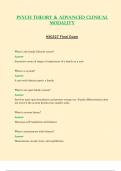College aantekeningen
Lectures and working lectures Genetics and Public Health (minor Biomedical Topics in Healthcare)
Summary of all lectures and working lectures given in the course Genetics and Public Health (part of the minor Biomedical Topics in Healthcare at the VU). It contains all the material you need to study for the exam. I got an 9.2 at the exam with this summary. (voor o.a. gezondheidswetenschappe...
[Meer zien]














